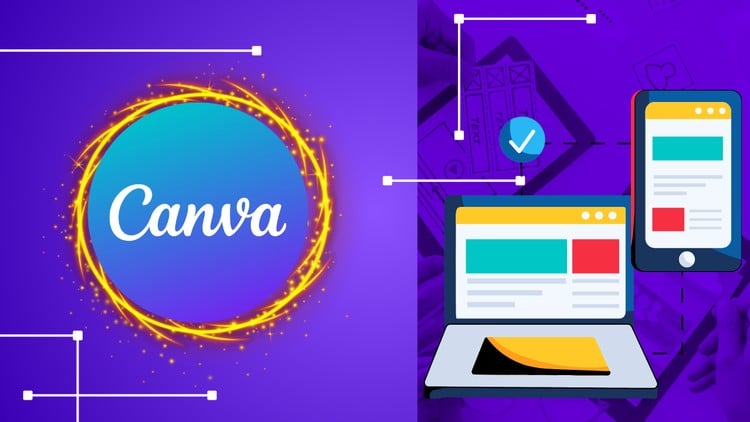
Build stunning user interfaces and experiences, from wireframing to interactive prototypes.
⏱️ Length: 4.2 total hours
⭐ 4.46/5 rating
👥 5,916 students
🔄 August 2025 update
Add-On Information:
Note➛ Make sure your 𝐔𝐝𝐞𝐦𝐲 cart has only this course you're going to enroll it now, Remove all other courses from the 𝐔𝐝𝐞𝐦𝐲 cart before Enrolling!
-
Course Overview
- Embark on a concise yet comprehensive journey into the fascinating world of user interface and experience design.
- Master the art of creating intuitive, engaging, and visually appealing digital products using the accessible power of Canva.
- Transform abstract design concepts into tangible, user-centric visual representations with remarkable ease and speed.
- Learn to craft interfaces that are not only aesthetically pleasing but also highly functional, driving user satisfaction.
- Demystify the core principles and psychological underpinnings of effective digital product design for modern platforms.
- Uncover precisely how strategic design choices influence user interaction, comprehension, and overall digital experience.
- Equip yourself with the fundamental skills to rapidly conceptualize, prototype, and execute compelling design ideas from scratch.
- Empower yourself to articulate sophisticated design visions and bring digital product concepts to life without the barrier of complex, specialized software.
-
Requirements / Prerequisites
- No prior experience with design software or UI/UX principles is necessary; this course is built for beginners.
- Basic computer proficiency and reliable internet access are required to engage with course materials and Canva.
- A genuine interest in digital design, creative problem-solving, and understanding how users interact with technology.
- Access to a Canva account (the free tier is often sufficient, but a Pro account is recommended for full feature access).
- An open mind and eagerness to explore creative visual solutions for various digital product scenarios.
- A desire to learn the foundational aesthetics and functional considerations behind successful digital product interfaces.
-
Skills Covered / Tools Used
- Strategic visual composition: Learn to arrange interface elements for maximum impact, clarity, and visual hierarchy.
- Rapid visual ideation: Develop proficiency in quickly generating and refining diverse interface concepts using Canva’s intuitive tools.
- User-centric visual translation: Master the process of converting user needs and behavioral patterns into clear graphic representations for digital products.
- Effective digital product storytelling: Craft interfaces that guide users seamlessly through an intuitive and engaging narrative flow.
- Collaborative design iterations: Leverage Canva’s features for efficient feedback loops and iterative improvements within a team or client context.
- Cultivating an expert eye for digital aesthetics: Develop a keen sense of what constitutes effective, attractive, and user-friendly digital visuals.
- Component-driven visual assembly: Learn to build and utilize reusable design elements for consistency and efficiency within Canva projects.
- Seamless design process management: Understand and implement a streamlined workflow from initial concept sketches to polished visual output.
- Adaptive interface design for varying displays: Acquire techniques to ensure your designs function optimally across different device screen sizes and orientations.
- Crafting engaging interactive components: Design visual elements that clearly invite user action, provide feedback, and enhance overall interaction.
- Developing cohesive visual identity systems: Ensure brand and style consistency across all interface elements for a unified user experience.
- Designing with basic accessibility considerations: Implement foundational practices to make interfaces more usable and inclusive for a broader audience.
-
Benefits / Outcomes
- You will gain the ability to effectively visualize and communicate complex digital product concepts with clarity and precision.
- Develop robust confidence in utilizing Canva as a powerful and accessible tool for a wide range of UI/UX design tasks.
- Graduate with a tangible portfolio of user interface concepts, ready to showcase your foundational design skills.
- Acquire the capacity to contribute meaningfully and articulately to design and product development discussions.
- Achieve independence from expensive, specialized design software, making high-quality design accessible to everyone.
- Benefit from a fast-track entry point into the fundamental principles and practices of digital interface design.
- Enhance your creative problem-solving skills, applying them directly to visual and interactive design challenges.
- Gain the power to quickly bring your app ideas, website layouts, or dashboard concepts to visual reality.
- Cultivate a solid understanding of the visual language underpinning successful and engaging digital products.
- Increase your versatility and marketability in tech-adjacent roles requiring a strong grasp of visual design insight.
-
PROS
- Highly accessible: Utilizes Canva, a widely available and easy-to-learn platform, significantly lowering the barrier to entry for design.
- Rapid skill acquisition: The short course duration is optimized for quick learning and immediate application of UI/UX fundamentals.
- Practical focus: Emphasizes hands-on creation of real-world design assets and interfaces, fostering practical proficiency.
- Cost-effective: Leverage free or highly affordable Canva options, making professional-level design training accessible on a budget.
- Versatile applicability: Skills learned are immediately useful for personal projects, startups, small businesses, or entry-level design contributions.
- Foundational understanding: Provides a strong, well-structured base for individuals interested in pursuing further, more advanced UI/UX exploration.
- Convenient learning: Offered in a flexible online format, allowing students to learn at their own pace and schedule.
-
CONS
- Specialized tool limitations: While powerful for rapid design, Canva may not offer the granular control, complex prototyping capabilities, or advanced features of industry-standard UI/UX software for highly complex, enterprise-level design projects.
Learning Tracks: English,Design,Design Tools
Found It Free? Share It Fast!